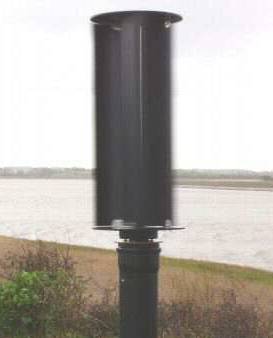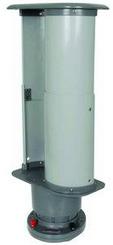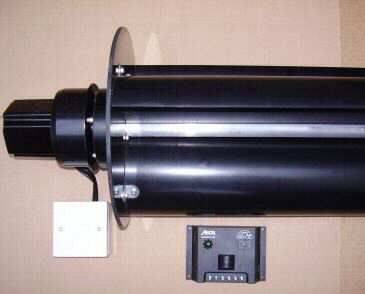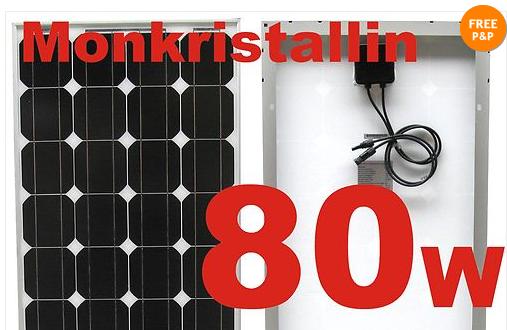 The generated AC electricity is then rectified into 12V direct current, passed through a 5A charge controller, to then maintain the charge on a 12V battery or battery bank. It is a Savonius type wind turbine.
The generated AC electricity is then rectified into 12V direct current, passed through a 5A charge controller, to then maintain the charge on a 12V battery or battery bank. It is a Savonius type wind turbine.
Over the next six years this turbine and its successor a two-blade Savonius 50 Watt micro VAWTpictured below were on sale in the UK from £120-200 and were even sold in Maplin stores on the UK high street.

These wind turbines have not been available to purchase in the UK since the beginning of 2013, and no similar product is available at present in the UK market place, so in this updated article we will look at what the Envirotek wind turbines offered and why at the end of the day they were not successful.
Wind Turbine Power Output
The key thing most people want to know when purchasing a wind turbine generator is the maximum rated power output – for example, the Envirotek V20 turbine was fitted to a 20 Watt generator, so the maximum power output from it was 20 Watts. The 50W VAWT was rated to output up to 50 Watts. However, the actual power coming out of a wind turbine generator depends on the wind speed at that instant, and that maximum power output will only occur in strong winds.
| Wind Speed | Charge Rate/day |
| 10mph | 3 Ah |
| 20mph | 8 Ah |
| 30mph | 20 Ah |
| 40mph | 30 Ah |
The Envirotek V20 was sold as having the specs shown above. Ah is a unit which measures charge – it stands for Amp Hours – so a battery containing 3Ah of charge can supply 3A for one hour, or 1A for 3 hours. 10 mph is quite a strong wind, but to get 3 Ah of charge into the battery in a 24 hour period would require this 10 mph wind to be maintained constantly. 3Ah in 24 hours is a charging current from the wind turbine generator of 125mA (0.125 Amps) which is just 1.5 Watts of power, far below the 20 Watt rating of the generator.

The specs also show power outputs of 4 Watts at 20 mph, 10 Watts at 30 mph, and 15 Watts at 40 mph. Now, unless you live on top of a windy mountain, or on a very exposed coastline you are rarely going to see even brief gusts of wind at 30 mph let alone constant 30 mph winds, and so the power output from this wind turbine generator was always likely to disappoint in real world conditions.
Turbine Size
So, what was the problem? The rotor swept an area of 26cm wide by 60cm high (= 0.156 square meters). Therefore (according to the calculation of wind power) there is only around 8 Watts of wind energy hitting the turbine in a 10mph wind, compared to around 60 Watts in a 20mph wind. Savonius VAWT type wind turbines are inherently quite inefficient and so no more then 20-30% of this wind energy can ever be exploited and sent to the batteries, so the theoretical maximum power that this size and type of wind turbine could ever get from a 10 mph wind is just 2.4 Watts. The specs stated 1.5 Watts in a 10 mph wind, but this was not a perfectly efficient Savonius type wind turbine and there are losses to consider in turning the AC voltage output into a DC voltage for battery charging etc.
In short, the wind turbine itself was too small to make meaningful amounts of power.
Turbine Price
Originally the Envirotex V20 was sold at just under £300 (without batteries but with a 6A charge controller) suggesting use with caravans and trailers, cabins and farm buildings, electric gate openers, water pumping, and moored craft for keeping 12 Volt battery systems topped up with power. With a real world power output of just a couple of Watts likely in a typical somewhat exposed location, selling this as a battery top up device was fair – it was certainly unsuited for applications in which batteries are regularly drained and need full recharging.
Even back in 2007 a 15 Watt PV solar panel could be purchased for around £80, and such a panel would do as good a job at keeping batteries topped up as the small Envirotek wind turbine. There was nowhere in the UK where it made financial sense to use this turbine instead of solar panels.

Since the prices of PV solar panels have plummetted over the last few years, you can now get an 80 Watt solar panel for under £80 which is far more competitive than even the successor to the V20 which offered double the power at half the price, particularly when you consider that the solar panel will last for 20-30 years with no maintenance where the turbine generator will surely not last anywhere nearly as long.
So, in conclusion this wind turbine was too small to make enough power to make the cost of manufacture worthwhile or to give it many practical uses, and the cost of the wind turbine was far too high relative to the maintenance free alternative of PV solar panels.
The subsequent telescopic (i.e. bigger rotor area when opened up) 50 Watt rated version of this turbine was sold as a mass market device which led to lots of people who know nothing about wind turbine generators purchasing them. Many were returned by disappointed customers as it was a bit confusing to be standing in a stiff breeze with trees swaying around you, but negligible power coming out from the generator.
There is definitely a gap in the market which will surely be filled for a Savonius type wind turbine generator product in the 50-250 Watt power output range, but it will need to output this power at more realistic wind speeds and be priced to compete with solar.